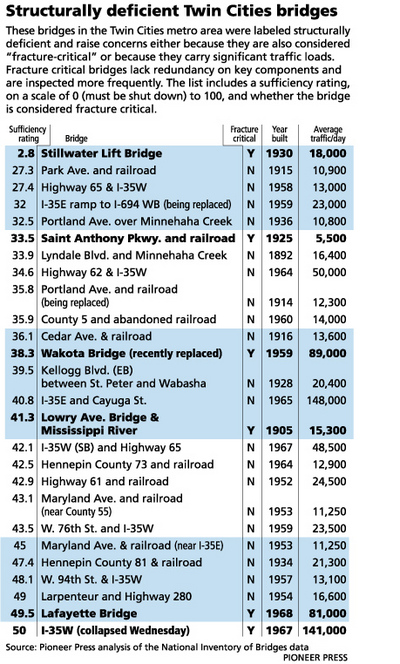The Highway 35 bridge over the Mississippi was one that I was pretty familiar with, but didn’t have to drive on too often in recent years. When it fell I had little trouble picturing it in my mind — or imagining the sensation of being one of those trapped on the span when it fell. I was very glad that I wasn’t on that bridge and that it wasn’t part of my direct commute.
Later, as we heard what was known about the condition of the bridge, I also thought about human nature and whether I would, if I knew the bridge’s condition, have continued to drive that bridge if it was the fastest way to work. How difficult would it have been to rationalize saving 10 or 15 minutes in order to drive on a bridge that even with its deficiencies was still considered safe to drive by experts? And how stupid would I have then felt when I felt the first tremor? I was glad that I hadn’t had to try and work that one out.
Or so I thought.
Over 100 state bridges rated worse than 35W
(Article and graph from St. Paul Pioneer Press, August 5.)
Before the Interstate 35W bridge collapsed into the Mississippi River, state engineers viewed another Twin Cities bridge as a more serious threat: the Lafayette Bridge in downtown St. Paul.The span over the Mississippi River is scheduled to be replaced in 2011 – many years before the I-35W bridge would have been – and suffers the same key defect that experts say contributed to Wednesday’s disaster. It was built with an outdated design that doesn’t prevent the entire structure from falling if one component fails.
“Drive across the Lafayette Bridge in rush hour sometime,” said Ramsey County Commissioner Tony Bennett. “It shakes. I won’t drive on it. That bridge is in dire need.”
The Lafayette is one of about 100 bridges in Minnesota considered to be in worse condition than the I-35W span that crumbled during rush hour Wednesday, according to a review of inspection records. The collapse has left many wondering how one of the state’s most heavily traveled bridges could have simply succumbed during normal, everyday traffic.
…
MnDOT engineer Chris Roy, interviewed before the collapse of the I-35W bridge, said the Lafayette has structural flaws and called it a “high-maintenance” bridge. It received a “poor condition” rating for its superstructures (I-beams, girders) and a “fair condition” rating for its deck. The substructure is in “good condition.”
The bridge also suffers the same inherent flaw as the I-35W bridge – it was built without structural redundancies.
“It’s a type of bridge design that we wouldn’t build anymore,” Roy said.
The Lafayette Bridge is part of my commute, and I’ve driven it at least twice a day for ten years, plus countless other trips into St. Paul. I have felt it bounce and vibrate at times, and I have looked over the edge (especially when south-bound) at the long drop that makes my knees tingle at the prospect, even before the recent and dramatic demonstration that bridges can fail.
Hearing that the Lafayette Bridge was considered to be in more immediate need of replacement than the (when it was still standing) Hwy. 35 bridge, I had to ask myself another question: “Do you feel lucky, punk?”
So today I took 35E to Ayd Mill Road and got onto Hwy. 94 east of Hwy. 280 where the congestion was really starting to back up. It took 45 minutes to get to my office, which is about what it’s been taking “normally” this summer with the effects of all the other road construction in the system keeping traffic clogged during a time of year that is usually pretty free-flowing due to significant parts of the workforce taking vacations any given week. I also have the choices of the Wabasha and Robert Street bridges (lovely bridges, but you have to crawl through downtown St. Paul to get to the highway).
I understand that “deficient” doesn’t mean “defective” and that in engineering terms the Lafayette Bridge is still considered adequate. The story I cited above also reports that the old Wabasha bridge had a “4” rating before it was ultimately closed and rebuilt in ’96, and that the Stillwater Lift Bridge has a 2.8 rating and people are still driving over it. I understand that there are bridges with lower ratings still being used. I also, however, understand that “fracture critical” means that the Lafayette Bridge, like the 35W bridge, has no safety redundancies if part of it starts to go.
You know, the scenery is really rather nice along Ayd Mill Road.
Update: Another story in the Strib today describes more concerns with the Lafayette Bridge, including an incident when a large crack in the main beam led to a 7″ dip in the roadway.













It just shows mans fallibility and vulnerability, and that we can’t be perfect. I just dread the blame game.
Have you heard any of the testimonies from Teen Challenge yet? I saw our pastor last night and he said he spoke with someone over there and they told him a couple of remarkable stories.
They have a van that travels over the bridge every Wednesday around 6:00-6:10. On that day they had a hold-up with one of the passengers, and left late. They were on the highway just short of the bridge when it collapsed.
Another staff person was driving to work, heading towards the bridge. She was almost to the bridge, which she always took, when she felt an urgent prompting in her spirit, and took the exit before to go another way. She saw it collapse within seconds of taking the other exit. She would have been right on it.
Holy Ghost goose bumps.